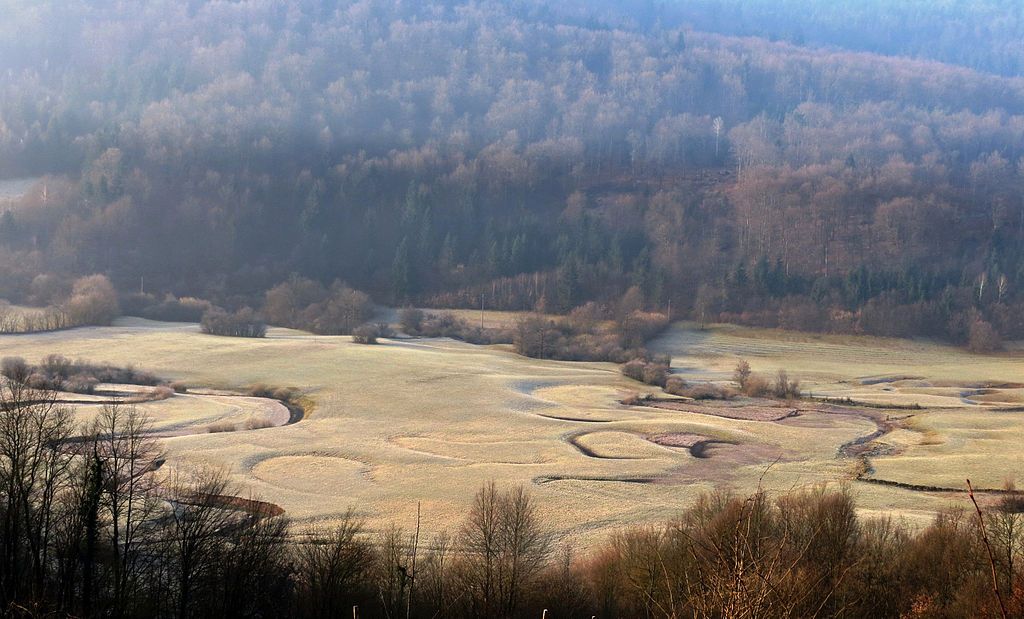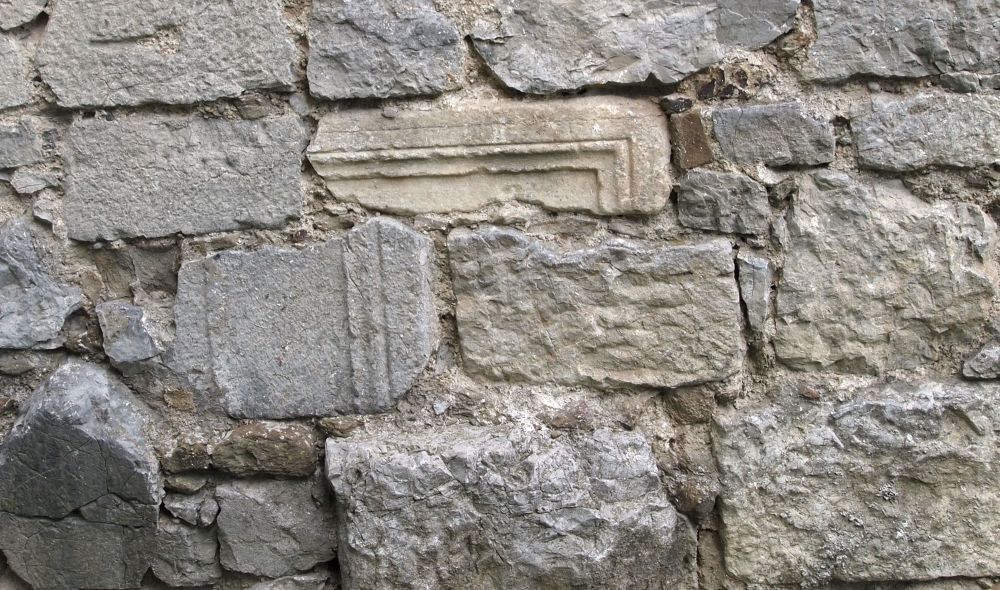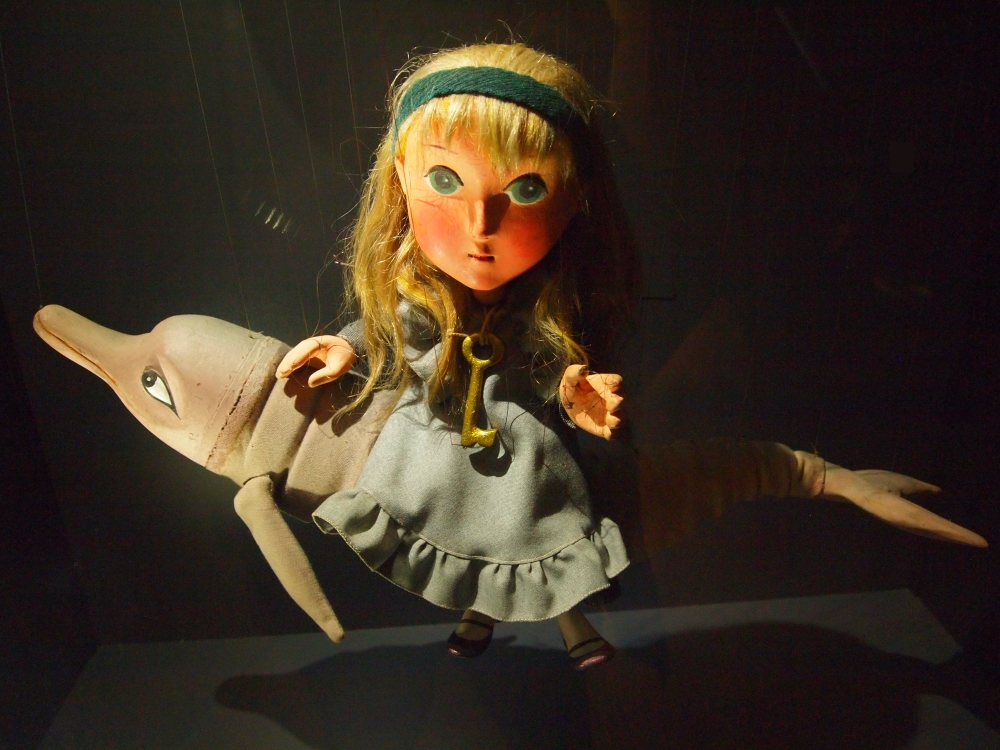Travel
The lights get turned on in Ljubljana at 17:15, Friday November 30 (2018), and in recent years an increasingly popular place to see this happen is not where the switch is flicked – the still busy Prešeren Square, by the tree – but instead up at the Castle, where you can get a bird’s eye view of the action and then go down and experience it close up, two ways to see the city in one trip.
But it’s not just views of the city that Ljubljana’s top attraction offers during advent, as the place also has seasonal activities of its own in addition to all the usual ways to enjoy it (as laid out, for example, in Ten Ways to Enjoy Ljubljana Castle).
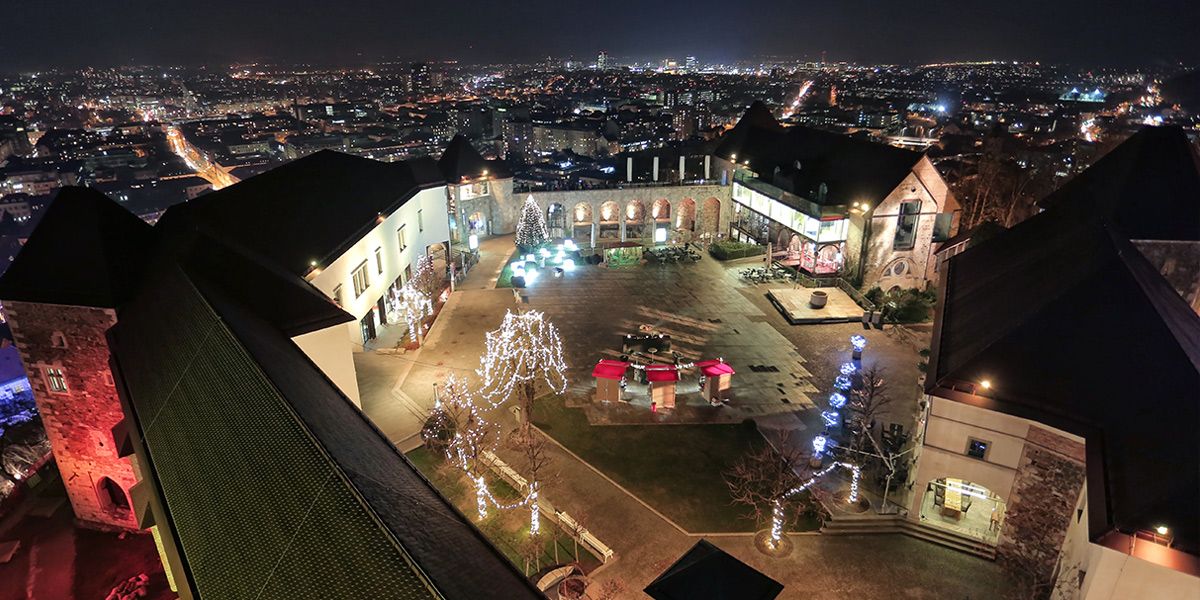
The courtyard from the Viewing Tower in an earlier year. Photo: Miha Mally, www.ljubljanskigrad.si
This Friday thus also marks the start of the festive fair in the Castle courtyard, which will have decorations and stalls selling seasonal food and drinks, including mulled wine in case you forgot to bring gloves. The same day will also see the display of life-size wooden sculptures making up a Nativity Scene, which can be visited until January 6 in the Lower Lapidarium.
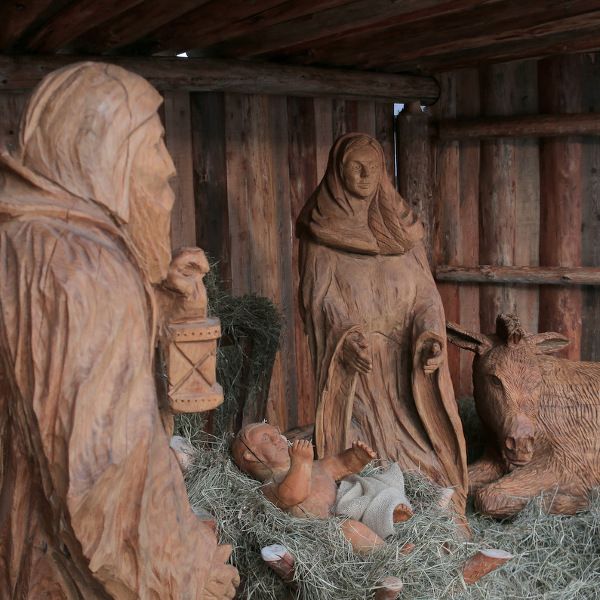
Photo: Miha Mally, www.ljubljanskigrad.si
Starting a week later, on December 5, is a new exhibition in the Pentagonal Tower, the original entrance to the Castle. This appeals to the Christmas message of helping the poor, sick and unloved, and will give you the chance to adopt a UNICEF rag doll. For a donation of €20.00 UNICEF is able to vaccinate one child against six contagious diseases, while you’re able to take home a charming doll for yourself or as a gift.
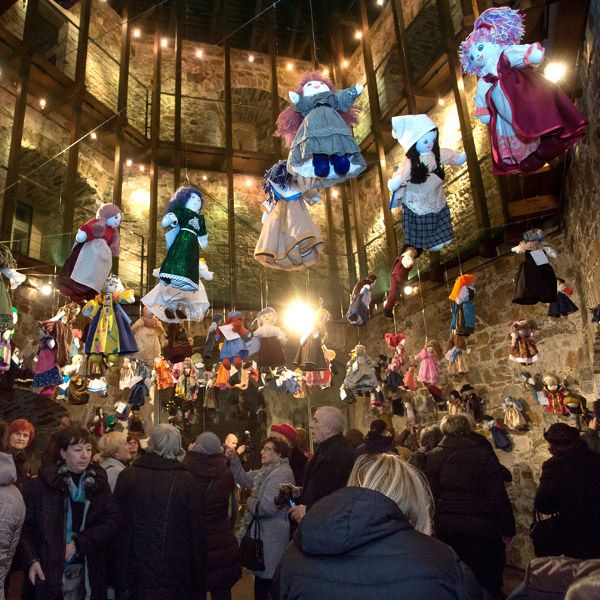
The dolls in the Pentagonal Tower. Photo: Nada Žgank, www.ljubljanskigrad.si
A little closer to the big day is Awaken the Dragon, a free architectural projection and 3D mapping experience that will bring to life the story of the Ljubljana Dragon. This is a new attraction at the Castle, and can be seen every day, from 21 December 2018 to 2 January 2019, between 17:00 and 20:00.
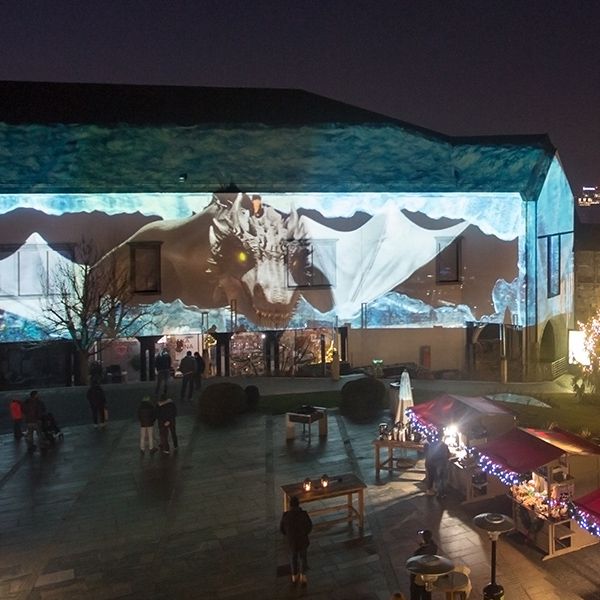
Awaken the Dragon will use the Castle as a projection screen. Photo: Miha Mally, www.ljubljanskigrad.si
On December 22, a Saturday, there’s Festive Dancing at the Castle from 20:00 on, with Latin American and festive music. Tickets include a ride up and down on the funicular, and entrance to the viewing tower, with more details here.
The Christmas events come to a peak on December 24, when you can visit the Chapel of St George for Christmas Holy Mass, starting at 22:00, with the service enhanced by festive songs performed by the Choir Megaron. However, note that this chapel is a small one, and seating will be rather limited if a crowd turns up.
The month and year then end on December 31, when the fireworks that light up at the sky at midnight will be taking off from the Castle, encouraging oohs and ahs from the crowds in the city who have come out to enjoy the various concerts in squares around town.
In addition to these seasonal events the Castle continues with it’s regular Friday night jazz concerts, with the schedule here and more details, including video, found by clicking the artist’s name. There’s also more on dragons, those from Ljubljana and elsewhere, with the exhibition The Dragon of All Dragons continuing until January 6 2019. In short, while a trip to the Castle is rewarding anytime you’re in the city, in the last month of the year there’s even more to see and do at the top of the hill that watches over Ljubljana, when it’s open from 10:00 to 22:00. And if you're in town and want some other things to do, beyond the Castle, then check out our latest What's on guide... here
Saint Nicholas (Miklavž) in Slovenia
The night air is filled with the cold vapour of tiny breaths as children gather in Prešeren square, eagerly awaiting the first of three presents they will receive over Christmas. The trees glisten with colourful lights and parents sip mulled wine to keep warm. The children are gathered around an old man with a long white beard, carrying a long golden staff and handing out sweets, fruit and other small gifts. You could be forgiven for thinking that this man was Santa Claus, but in fact this isn’t the jolly, red-faced man that most of us expect to squeeze his portly figure down our chimney on Christmas Eve, but this is in fact the real Father Christmas: Saint Nicholas.
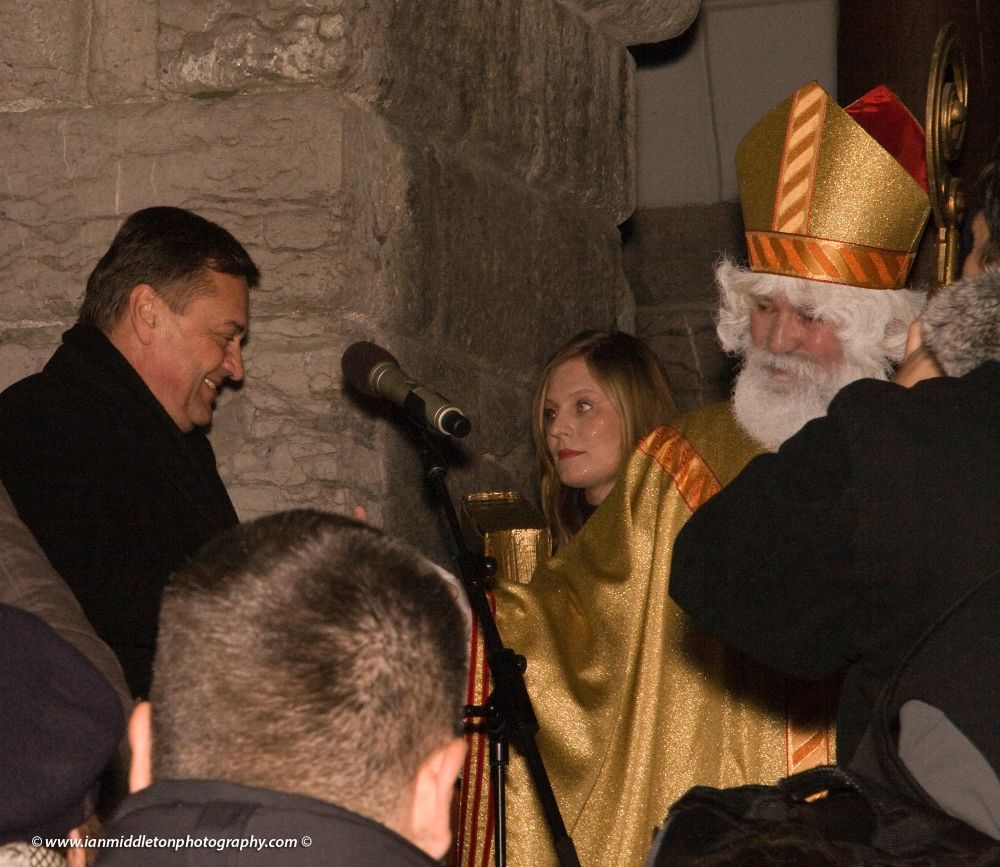
The Mayor of Ljubljana with Miklavs in Ljubljana centre. Photo: © Ian Middleton
Every year, on December 5th at 5.00pm, Ljubljana plays host to the Saint Nicholas procession, which marks the first of the three traditions of Christmas in Slovenia. Saint Nicholas is the universal name for Nicholas of Myra, a Christian Saint of the ancient town of Myra; a region in modern day Antalya in Turkey. He was born in AD270 and died 6thDecember, AD343. The Saint was renowned for his generosity. Legend says that he put coins into the shoes of people who left them in front of their house. He was especially revered for saving three girls from prostitution by providing them with dowries so they were eligible for marriage.
Related: Where and when to find Miklavž in Slovenia (2018 edition)
Even though he is a famous figure all across the Christian world, his image has been especially entrenched into Slovenian culture. Known here as Miklavž, tradition says that he comes from heaven on the eve of his death, 5th Dec, and bestows gifts of sweets, fruit and biscuits upon the children. He is accompanied by a flock of angels, who assist him to disperse the gifts to all the children who have been good that year. He is closely followed by parklji ‘the trotters’, the personifications of the devil who come and scare the bad children. The angels are also there to protect the bad children from the devil and warn them to be good in future years. The procession begins in front of the town hall in Mestni Trg, and continues on to Prešeren square where he addresses the crowd before disappearing into the Franciscan Church. Miklavž is depicted as having a long white beard and wears a long white Christian robe and a bishop’s hat.
The tradition of Miklavž isn’t limited to this procession, however. In the homes across Slovenia children put a shoe or stocking inside or outside their bedroom on Dec 5th and awake the next morning, in essence Saint Nicholas’ Day, to find it filled with food; typically the carob bean, mandarins, dry fruits such as dates, chocolates and other small snacks. The belief doesn’t promote lavish spending, but rather small, humble gifts totalling no more than a few euros.
Santa Claus in Slovenia
It’s actually from the story of Saint Nicholas that the modern day Santa Claus comes. His story was blended with the beliefs of other countries, and also pagan gods, to create the variations we see today around the world. The British created Father Christmas, who was blended with the Dutch Sinterklaas by the British and Dutch colonists in America to create the American Santa Claus. Various stories and publications further personified the image of Santa and the commercial image we see today was proliferated by a Coca Cola advert in 1930 in the USA. This image of Santa spread around the world and like most countries Slovenia embraced this belief, calling their Santa, Božiček. The Christian Saint Nicholas and the commercial Santa were discouraged during the Socialist era under Yugoslavia, but were revived shortly before independence. Slovenian children now get to experience the more modern commercial Christmas where the gifts are brought on the eve of the birth of Christ. But one difference here is that many families have their Christmas dinner on Christmas Eve, before going to holy mass. While the main meal is much the same as elsewhere, a unique desert served after dinner is a nut roll called Potica.
The Christmas customs here remain much the same as around the world; families decorate their homes and trees and children in schools compete to make Christmas Cribs, small boxes with dolls depicting the nativity. The most famous and elaborate depiction of the nativity is found in Postojna Caves. Over the Christmas week the banks of the Ljubljanica come alive with open-air bars selling hot food and drinks, including mulled wine to keep you warm on the freezing cold nights. The centre is lavishly decorated with a myriad of coloured lights, all of which are ceremoniously switched on at a big event on 3rd December at 5.00pm to not only mark the beginning of the Christmas period, but also to coincide with the birthday of France Prešeren.
Grandfather Frost (Dedek Mraz) in Slovenia
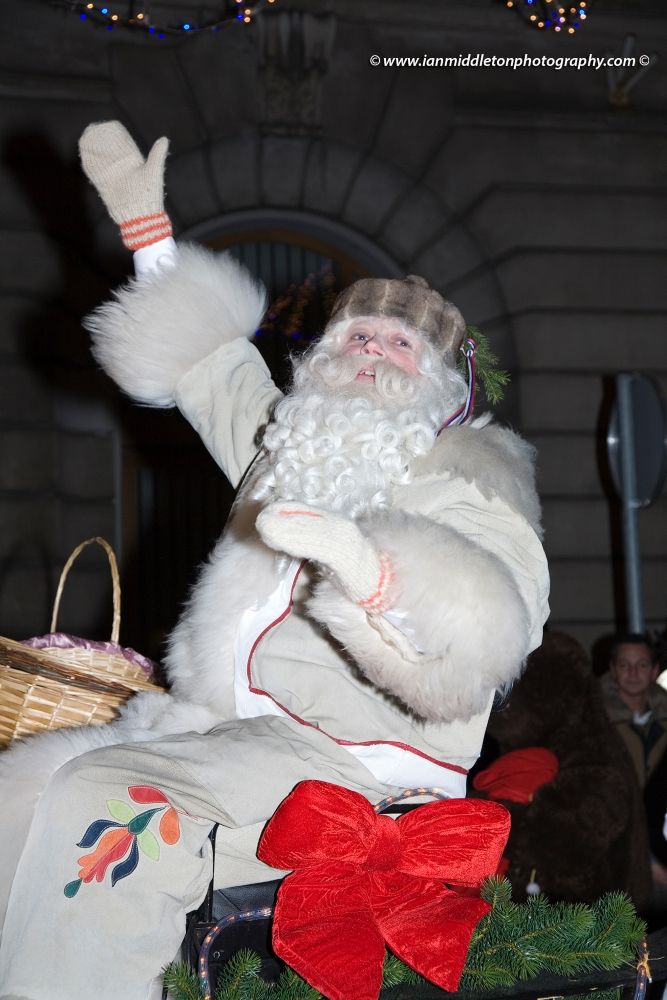
Dedek Mraz procession in Ljubljana, Slovenia. Photo: © Ian Middleton
December 31st sees the arrival of the third of Slovenia’s gift-bearers. Prior to 1991 the commercial Santa was not popular here. Historically, Saint Nicholas was commemorated. During the years under Yugoslavia though, all religious and commercial celebrations were frowned upon, but rather than ban them completely and be made to seem like the killjoy, the authorities replaced them with the Russian communist Ded Moroz, which was translated into Slovenian as Dedek Mraz, literally Grandfather Frost, but sometimes referred to as Grandfather Cold.
Dedek Mraz originated from the pagan culture of the Eastern Slavs, but became entrenched into Russian communist society as an alternative to western beliefs. Unlike Santa, Grandfather Frost doesn’t sneak presents to the children during the night, but hands them out personally at gatherings on New Year’s Eve. During the Socialist years companies would arrange a special event in a hall. The workers would bring their children and they would meet Dedek Mraz and be given a gift. But this gift-bearer is in stark contrast to the jolly fat Santa, being slim and wearing a long white coat and brown furry Russian kučma hat.
The break-up of Yugoslavia saw the open return of Miklavž and Santa, but Grandfather Frost was not tossed out with the rest of the Former Yugoslavia’s ways, but integrated into the new ways, thus providing Slovenian children with the providence of three days over Christmas where they receive presents. Dedek Mraz is believed to have his home under Triglav and emerges close to New Year’s Eve to visit children all across Slovenia.
From Dec 26th to 30th Dedek Mraz will ride through Ljubljana on his carriage pulled by two Lipizzaner horses and appear in Krekov trg, Ciril-Metodov trg, Stritarjeva ulica, Prešernov trg, Wolfova ulica and Zvezda Park.
Today many families follow the tradition of all three, and rather than being the enemies of the old ways they have been harmonized and each has retained his place in Slovenian Christmas tradition.
The week of celebrations along the Ljubljanica culminate in a climatic display of fireworks launched from the castle overlooking the old town and city centre. Crowds gather in Prešeren Square and along the river to view this spectacle and see in the New Year with wine, champagne and music.
Related: Turning on the Christmas Lights in Slovenia - when and where to see them

Fireworks from the Castle above the Old Town in Ljubljana, Slovenia for New Year’s Eve 2007/2008. Unfortunately fog obscured the Castle. Photo: © Ian Middleton

Dedek Mraz procession in Ljubljana. Photo: © Ian Middleton
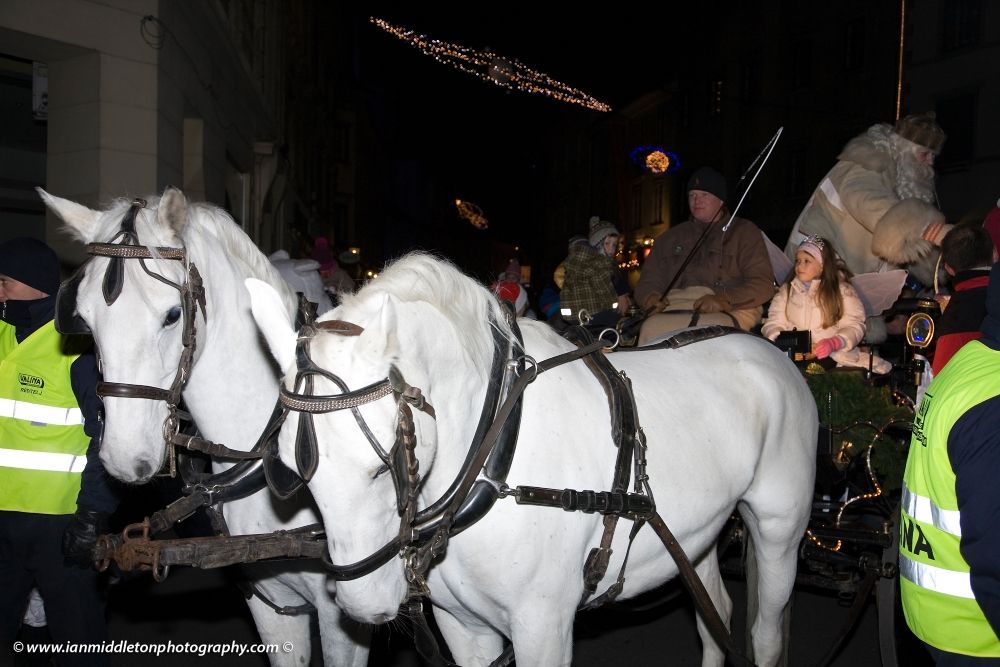
Dedek Mraz procession in Ljubljana. Photo: © Ian Middleton
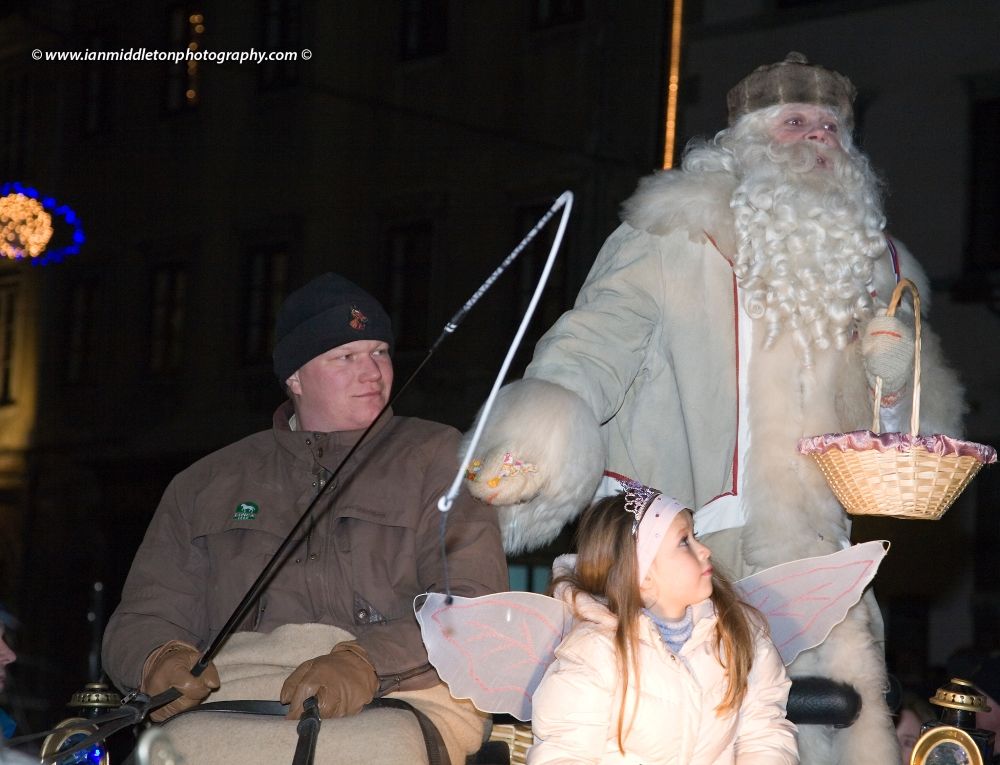
Also known as Grandfather Cold or Grandfather Frost, this tradition was used by the communists as a replacement for the western Santa Claus. The tradition comes from an ancient Russian Legend of Ded Moroz, and he wears a white outfit and Russian Kuchma Hat. Photo: © Ian Middleton
You can enjoy more of Ian's travel writing and photography elsewhere on Total Slovenia News, or on his website.
Slovenian Karst in line for world recognition
The compact yet varied topography of Slovenia holds many wonders, a fact the tourism industry has long thrived on. Soon another of its geographic features could be in the spotlight, as the Classical Karst region is being nominated to join UNESCO’s Natural Heritage list. As noted by the STA, a report on the area between the Ljubljana Marshes and the Bay of Trieste has been submitted by the government to UNESCO, with the project being led by Park Škocjanske Jame, the operator of the Škocjan Cave system that is already part of the organisation’s World Heritage list, along with the Slovenia’s ancient and primeval beech forests, prehistoric pile dwellings, and mercury mines.
The Ponikve Karst Field in Dolenja Brezovica, Municipality of Brezovica, Slovenia. Photo: Wikimedia - DOREMO - CC-by-4.0
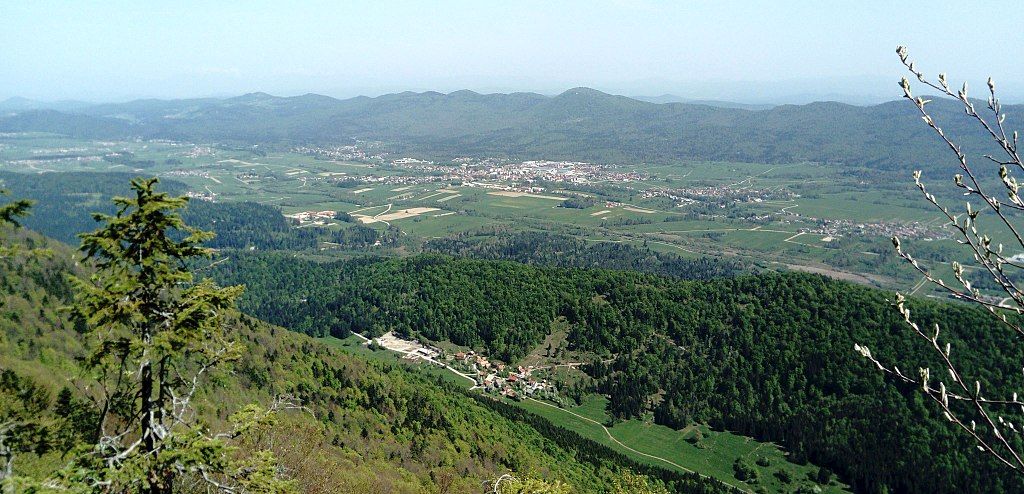
The Ribnica Valley or the Ribnica Field, a karst lowland in southern Slovenia Photo: Wikimedia - Eleassar CC-by-4.0
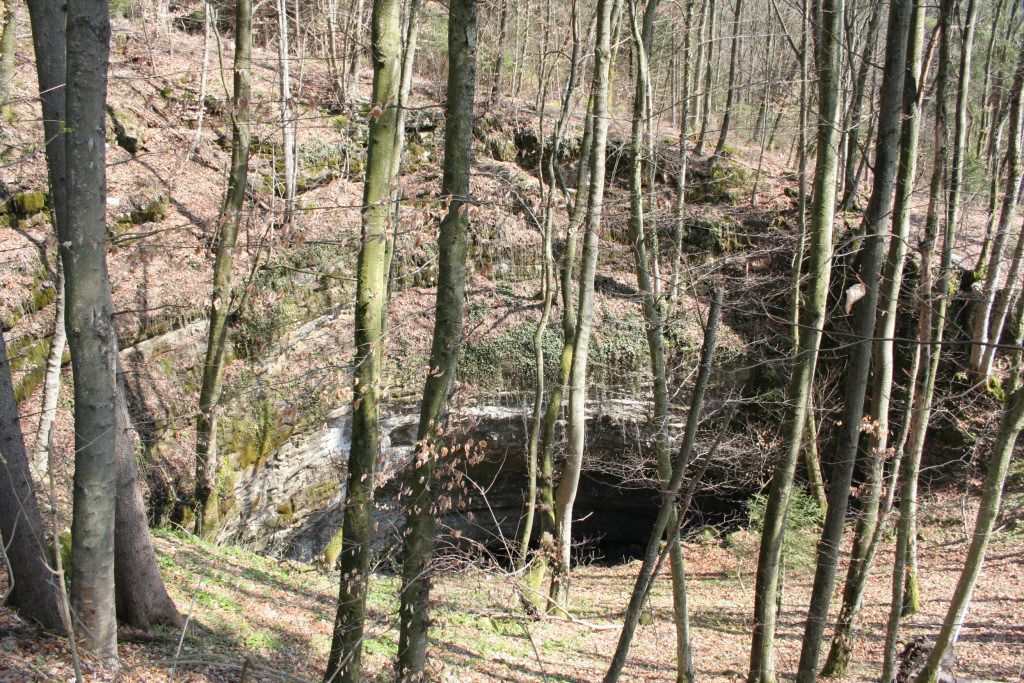
Udornica or collapse doline in Slovenian karst on Radensko polje near Grosuplje. Photo: Wikimedia, Tcie CC-by-4.0.jpg
A look at the original submission, made by the Permanent Delegation of Slovenia to UNESCO two years ago, goes into some detail as to why the Classic Karst (Klasicni kras) deserves greater recognition and protection.
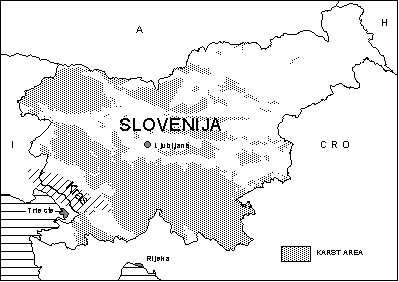
Geographical position of Kras. Map: lter.zrc-sazu.si
For one, karst is the most widespread landscape type in Slovenia, covering around 6,400 km2or 27% of the territory, stretching from the Ljubljana Marsh (Ljubljansko barje) to the Bay of Trieste, and holding roughly 6,000 known and explored caves. These include massive systems like Postojna Cave (Postojnska jama) and the Skocjan Caves (Skocjanske jame), which have been attracting explorers and tourists since the 17th century.
Enough to render Slavoj Žižek speechless
But it’s not just the natural beauty of the rock forms or the wonder of the subterranean vistas that mark the karst region as a treasure worth preserving for future generations. It’s also one of the richest areas in Europe with regard to flora and fauna, and one recognised as a hotpot of biodiversity, with much more to this than such iconic animals as the proteus, aka “human fish”. It’s also an area with a long history of human habitation, with the earliest artefacts found so far being from the Palaeolithic.
The area has thus attracted researchers from various fields, and played an important role in the the history of research into karst and karst phenomena, also known as karstology and speleology, respectively, with such efforts being led in Slovenia by the Karst Research Institute (lnstitut za raziskovanje krasa), based in Postojna.
A more conventional video promoting Karst tourism
The submission to UNESCO goes on note five areas in particular that are of “outstanding universal value”: the Kras (Kras), the Podgrad lowland (Podrgrajsko podolje), the Postojna Karst (Postojnski kras) and the Poljes of the Classical Karst with the Rakov Skocjan valley (Kraska polja z Rakovim Skocjanom), with more details available in the document.
If you’re curious about making a day trip to the karst from Ljubljana, then consider Postojna or Predjama, with the latter having the added attraction of a castle build into the caves. If you’d like to read more about “Castles, caves and the birth of karstology”, then you can do that here.
While one peak of tourism in Slovenia occurs in August, another is in December, when instead of green pastures and forests the country offers whiter, brighter scenes of snow and ice. While some spend their time in the great outdoors, skiing, sledding and so on, others prefer to warm their hands around a glass of mulled wine while looking at all the pretty lights. And if you’re in the latter camp then you’re in luck, as preparations are well under way to turn various town centres into magical places at night, not only lit up but made merry by stalls selling food, drink, decorations, hats, gloves, scarves, and so on.
So while you may not have unpacked your winter jacket yet, Festive December is atill fast approaching, those four weeks before Christmas that see appearances from, among others, St Nicholas, Santa Claus, Grandpa Frost and the Krampus, and if you’re planning a trip to Slovenia then these are some light shows to consider taking in on your stay.
December in Ljubljana
The lights that keep the capital festive were designed by Zmago Modic, the artist who’s also responsible for the rain that appears each summer in Prešeren Square. And it’s in this square, soon to be home to a giant Christmas tree, where the lights will be turned on Friday November 30 at 17:15. Thus will begin a month or so of merriment, fuelled, as elsewhere in Slovenia, by stalls selling mulled wine, hot food and other seasonal delights, along with live music at various open air venues around town, with the action very easy to find. The city’s official site for the month is here. Note that this year no ice rink is planned for Zvezda Park, perhaps because of the mild, rainy winter last year, which saw it rather quiet.
If you're in the capital now, check out the latest edition of What's on... for an incomplete selection of things to do in things to do in Ljubljana this week.
December in Maribor
The lights in Maribor will start shining a week earlier than those in the capital, with the switch being flipped at 17:00 on Friday November 23rd in General Maister Square. A full programme of events if planned for that day, with details here. As well as all the usual stalls and merriment, Maribor will have an ice rink in Trg Svobode. The city’s official site for the month is here.
December in Bled
The picturesque lake, island, chapel and castle are especially magical in winter, with the scene made even more full of wonder when the lights come on at night. This year the festive season will run from November 30 until January 6, and – in addition to the usual lights and stalls – there’ll also be an ice rink with a spectacular view. The official website is here with more details, and note that if you’re in the area on Christmas Day then you have the chance to join other brave souls and go for a swim in the lake.
December by the Coast
Of course, not everyone likes the cold and snow, even in December, in which case a festive trip to the mild climate the Slovenian coast is recommended. All the towns here will have lights to enjoy, starting on December 1, but if in Portorož then head to Christmas market in the park of Hotel Kempinski Palace Portorož, while in Koper the Old Town will come alive to a series of events call Magical December, usually including an ice rink. Finally, in Piran the centre of festivities will be Tartini Square.
STA, 9 November 2018 - An exhibition has being launched at Khislstein Castle in Kranj which sheds light on the family that gave the 13th century castle its name and its present appearance 440 years ago.
The Khisls were an important family in Slovenian lands in the 16th century, owning estates across the historic regions of Carniola and Styria. Their last known descendants lived here in the mid-18th century.
They are believed to have come here from Bavaria or German-speaking lands. Their first member in Slovenia was merchant Vid Khisl, who became Ljubljana mayor in 1537.
Although not originally of noble rank, the family rose to prominence fast by acquiring wealth through business enterprise and moving up to a higher class.
Part of the reason for their prosperity was their involvement in the defence against the Turks and their good political and business links with the rulers.
Among other things, they won privileges to manufacture glass and built an iron mill for the manufacture of weapons and a paper mill.
A supporter of Slovenian Protestants and musicians, Janez Khisl issued what is the oldest known official document in the Slovenian language in 1570 as the provincial administrator of the time.
In the mid-16th century Janez Khisl bought a castle in Kranj and redesigned it before being granted the permission in 1578 to rename it Khislstein.
"I wonder why the family picked the Kranj castle to to name it after themselves when they had at least 30 estates and mansions in Carniola and Styria at the time. They obviously held the Kranj castle especially dear," Marjana Žibert, director of the regional Gorenjska Museum, said ahead of the launch.
The castle is the museum's main venue and the exhibition will also mark the museum's 65th anniversary. Running until September 2019, it will be accompanied by a 120-page catalogue.
The castle changed hands several times before it was bought by the state in 1913. It has been housing the regional museum since 2012, following the last renovation.
The castle attracts between 8,000 and 10,000 visitors each year, which makes it the second most popular museum in Kranj after the one dedicated to Slovenia's greatest poet France Prešeren.
The regional aviation website Eu-Yu Aviation reports that Adria Airways has quietly ended services connecting Ljubljana and Bucharest, Kiev and Warsaw. While no formal announcement was made, the airline omitted these cities in a recent press release, despite having advertised all three routes just two weeks ago in a seasonal promotion. Ljubljana Airport now has no direct flights to Bucharest or Kiev, although it’s still possible to fly to and from Warsaw using LOT Polish Airlines, which runs a daily service.
STA, 5 November2018 - With the United Kingdom being one of the key markets for Slovenian tourism, some 35 Slovenian companies and organisations are being promoted at London's WTM, a leading global event for the travel industry, which runs from Monday to Wednesday.
We are delighted to announce the iconic #Ljubljana Castle is our official #WTMLDN partner.
— Slovenia Tourism (@tourism_slo) November 5, 2018
The partnership is part of helping preserve the historic @Ljubljanskigrad, which has provided panoramic views of the city for 900 years.
⤵️Visit Stand EU1400 to learn more ? @WTM_London pic.twitter.com/Y9yHLlFFKq
Slovenia is being promoted under the auspices of the Slovenian Tourist Board (STO) as an attractive destination offering "five-star experiences".
A special emphasis is placed on culture, which is the main theme of the STO's promotional campaigns in 2018 and 2019.
The country's exhibition area, spreading on more than 175 square metres, features Ljubljana Castle as the main partner.
Related: 25 things to know about Ljubljana Castle
On Tuesday, the Slovenian pavilion will feature a meeting of Slovenian tourism industry representatives with British and global tour organisers plus global media.
Slovenian food will be served by chef Igor Jagodic and the author of the best article on Slovenia written this year will be declared.
Related: Get to know Slovenia’s cultural heritage through its 17 historic towns
STO director Maja Pak says that "as as one of the most important and globally recognisable fairs, the WTM is a unique opportunity to consolidate the existing and create new business opportunities as well as to connect with the tourism industry in the UK and wider."
Slovenia is recording a rise in arrivals and overnight stays by British tourists, according to Pak, who said that a 27% increase in arrivals was reported for the January-to-August period compared to last year.
Related: 25 reasons why you should never visit Slovenia
In 2017, British tourists accounted for 370,000 nights in Slovenia, whose tourist industry has posted strong growth over the past few years. They are mostly interested in the country's mountains, cuisine, ski resorts and culture.
See all of our TRAVEL stories here, and follow us on Facebook for the latest news and views from Slovenia
Ljubljana Castle is the most visited attraction in the city, and – so it’s claimed – in Slovenia. While an earlier post looked at 25 things to know about the building that has watched over the capital for centuries, below we present a list of ten different ways to enjoy your visit there.
Imagine the history
The Romans had a wooden fort on Castle Hill when Ljubljana was known as Emona, and built a well that still exists, just outside the entrance. What’s more, some of the stones that were used to build the Castle were repurposed from the ruins of the Ancient City, and can still be seen with their Latin engravings or decorations. Ljubljana Castle has almost 2,000 years of history, and the time you spend their can be used to link that with your own – a sobering thought to encourage you make the most of however much time you have left.
Roman stones in Ljubljana Castle. Photo: JL Flanner
Ljubljana is a green city. Photo: JL Flanner
See the city
The best views of the city are from the highest point in Ljubljana, which is the watchtower that a ticket to the Castle (or any of the tours) gets you into. However, note that the old architecture means there’s no disabled access or elevator here, so you’ll have to climb the steps. Still, if you can’t make it up, or don’t want to buy a ticket, don’t despair, as there are many other fine spots on Castle Hill from which to look at Ljubljana, from where it’ll be clear that this city really is set in the middle of a forest.
Most of Castle Hill is forested. Photo: Google Maps
Get some fresh air
While the Castle is large it still covers only a small part of the hill, which has many trails through the forest to explore, as well as grassy clearings, benches, small meadows and even a vineyard, making it an easily accessible escape from the city. Depending on the time of day and weather, expect to see joggers, dog walkers and others getting some fresh air, nearby by but far away from the tourists.

Tradtional Slovenian food at Castle restaurant. Photo: nagradu.si
Dine in style or al fresco
While the fine-dining options of Strelec and Castle Restaurant (Restaurant Na Gradu) get the headlines when talking of food at the Castle, there’s also a café for more casual fare, and beyond that the old place makes a great location for a picnic, if not within the walls then in a quiet spot along many of the trails that run along the top of the hill, where you can enjoy a sandwich along with, as noted above, the view.
The Puppet Museum is full of colourful and interactive exhibits. Photo: JL Flanner
Learn about Slovenia’s cultural heritage
As part of Ljubljana Castle’s mission to preserve, present and promote Slovenia’s cultural heritage it hosts a number of exhibitions, both permanent and temporary, all year round. While some of these are free, such as the one on the renovations to the Castle that have taken place since the 1960s, to be found under the courtyard, others require a ticket, though luckily this ticket will also get you access to the watchtower and other features of the complex. One thing of special interest to families – a permanent exhibition showing some of the history of puppetry in Slovenia, a trip to which perfectly complements a visit to the Puppet Theatre in Krekov trg, just by the funicular station. Learn more about the Castle’s current exhibitions here.
Book the place for yourself
The Castle and its halls can be hired for private occasions, and thus it plays host to conferences and presentations throughout the year, providing a memorable setting for many business events. More personally, it can also be used to weddings, with a dedicated office set-up to make the big day into a magical one. Learn more about hiring a venue here, and having a wedding or engagment partY in Ljubljana Castle here.

Lights make the place magical after dark. Photo: Branko Čeak for Visit Ljubljana
Go at night
Medieval buildings come after dark, when the shadows playing on the walls light up the imagination and romance of the past. Ljubljana Castle is no exception, and is a great place to visit after dark at any time of year. In addition to all the usual charms in the evening the Castle often hosts concerts, such as the regular Friday night performances, while in the summer months there are also films shown in the courtyard and under the stars, as well dances and other special events. You can learn more about the various events held at the Castle here, and you can visit it until 20:00 in January, February, March and November, until 21:00 in April, May and October, until 23:00 in June, July, August and September, and until 22:00 in December 10:00 to 22:00.
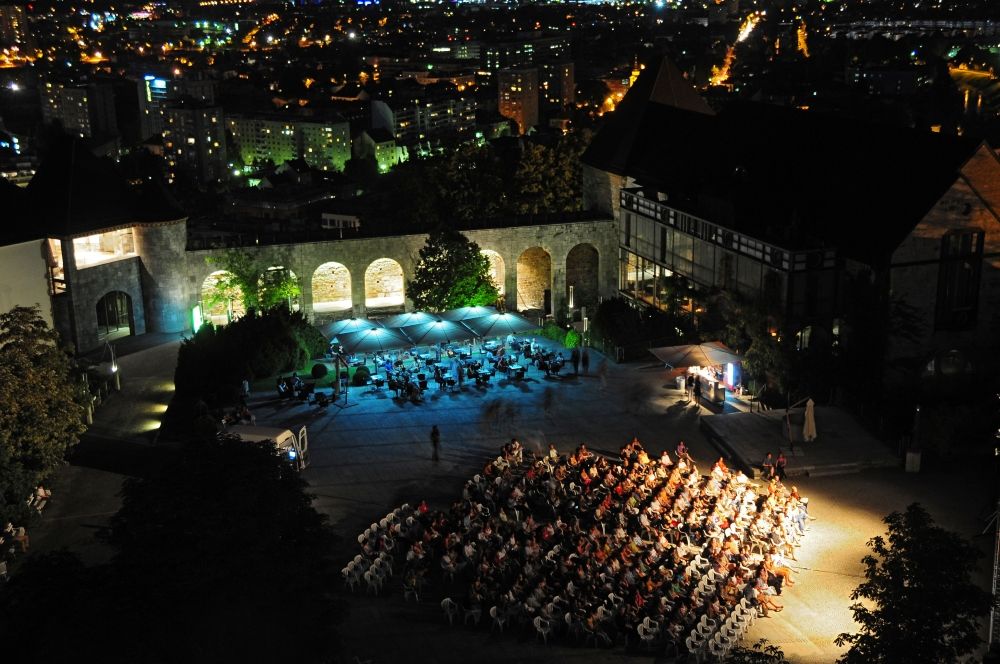
An event at night in the courtyard. Photo: D Wedam for Visit Ljubljana
The Castle in December
December is one of the most popular times of year for people to visit Ljubljana, drawn by the festive decorations in the city and the market stalls selling mulled wine and hot food, and the Castle is an essential stop on such trips. Not only can people get a great view of the Christmas lights in the streets below – with the evening these are switched on being an especially busy time – but they can also the decorations in the Castlem as well as other events, including Holy Mass in the chapel, at 22:00 on December 24.
Explore Ljubljana Castle with an app in 14 languages
The Castle may be old, but that doesn’t mean it doesn’t keep up with the times. You can download an app that introduces the place based on your location in the complex, and all you need is a smartphone and pair of headphones. The app is available in Slovenian, English, Hungarian, Croatian, Italian, German, French, Spanish, Portuguese, Dutch, Russian, Japanese, Chinese and Korean, and for both iOS and Android devices. The activation code for the app comes with a ticket to Castle, and can be collected at the Info Centre. More details here.
Enjoy it for free
Perhaps best of all for regular visitors, much of what the Castle has to offer can be seen for free, with only the watchtower and certain exhibitions requiring a ticket, while the other areas remain open to all. Combine a walk up one of the various paths that take you to the top from the Old Town with a stroll around the Castle walls and courtyard, perhaps settling down for a rest on a bench or snack, and you’ve got an adventure that’ll fill a few hours in fine style without breaking the bank. What’s more, there’s always something new to see, whether related to the changing seasons, an event on the day, a detail you’d never noticed before, or a group of visitors from a land you long to visit, delighted at the a place you know well – there’s always a good reason to go back to Ljubljana Castle.
The Castle is open all year, although with some changes with the seasons. January, February, March and November its open 10:00 to 20:00. April, May and October from 09:00 to 21:00. June, July, August and September from 09:00 to 23:00. December 10:00 to 22:00. However, now that these times are for the main Castle complex, and not necessarily for all the attractions, with more details here.
Related: 25 Things to Know about Slovenia's Green City of Dragons
Entrance to Castle courtyard is free, but if you want to see more you'll need to buy a ticket at the entrance, funicular station or Info Centre, with a basic ticket currently 7.50 euros for adults and 5.50 for children, students and pensioners, and there's also a family ticket for 19 euros. Note that tickets to tours also include entrance to all parts of the Castle, with more details here.
With 59 major rivers and 321 lakes within its small and varied topography, it’s no wonder that fishing in Slovenia is a popular activity, one that provides a way to explore the great outdoors, commune with nature, and hopefully bring something home for dinner. Still, it’s part of the nation’s tourist offering that we’re relatively unfamiliar with, and so when we came across Water Man Adventures, a company that organizes vacations with a focus on fly-fishing in Slovenia, we jumped at the chance to ask Robert Redding a few questions about the business.

Robert Redding
Where are you based, and how did you discover Slovenia?
Water Man Adventures has a presence in Colorado, USA, where I’m based, as well as in Slovenia where my business partners are.
I fell in love with Slovenia and its fly-fishing when I was posted to the US Embassy in Ljubljana from 2006 to 2009. I began the business last year in anticipation of my retirement from the military in 2019. I expect to be based in Slovenia once that happens.
What makes Slovenia especially attractive for people who enjoy fly-fishing?
The country’s geography and weather make it a very special place, and there’s good reasons why fishing in Slovenia is increasingly popular. Primarily, there is tremendous diversity in terrain and rivers in Slovenia – with a high concentration in the western part of this small country. In the northern/alpine region, the streams and rivers are cold all year long, and this makes them a highly oxygenated and suitable habitat for cold-water fish like trout (and fishermen too) even in the hottest time of the year. Additionally, fly-fishing in Slovenia is normally a bit easier because of the low-nutrient (oligotrophic) nature of those streams - fish just have to eat all the time in order to get ready for the cold winter. Therefore, summer usually means dry fly action practically all day, not just during mornings and evenings, as is typical elsewhere.
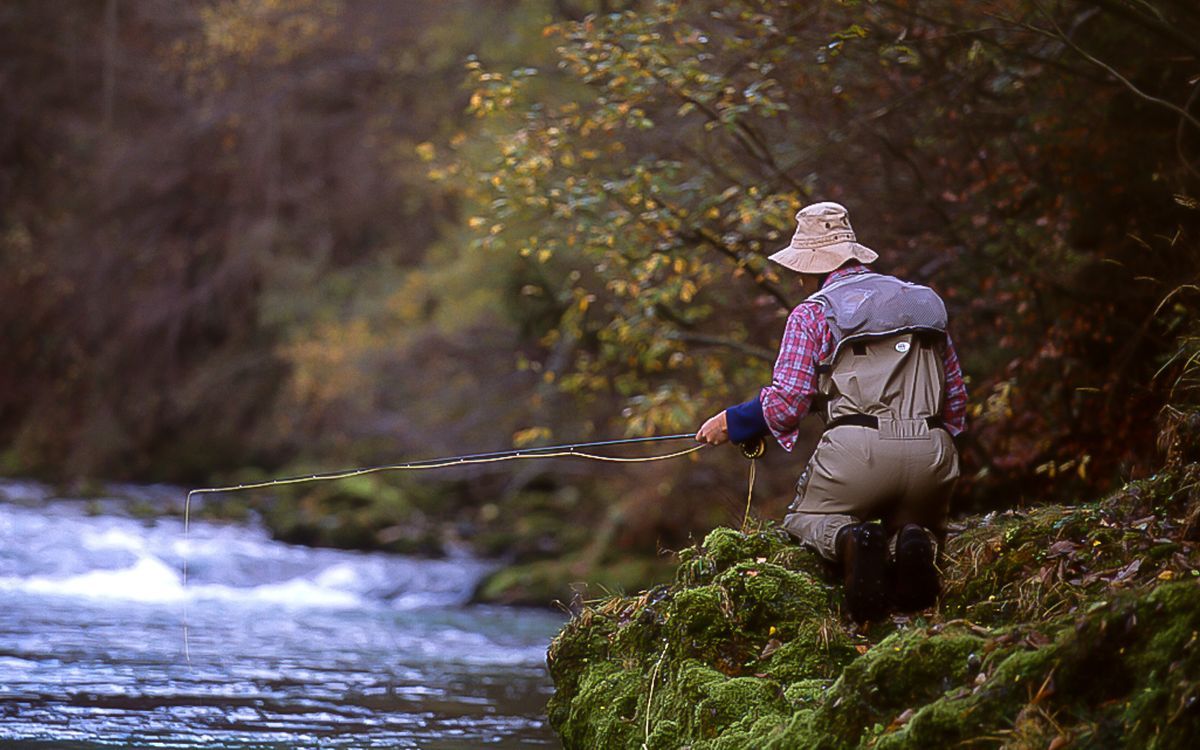
Trout fishing in Slovenia
The best part of Slovenia for fishing expeditions is that the distance between alpine and limestone waters is only a one hour drive. In fact, there are only two hours needed to drive through the whole country from north to south. Given both types of rivers, along with the lakes that are available, fly fishermen have a great opportunity for good fly-fishing conditions practically every day of the season. To make things even better, we can (and do) change regions and rivers during the fishing day in order to give clients the best opportunities to fish.
Where in Slovenia do you operate?
We take our clients primarily to places where there are trout in the rivers – and thus the water is clear and cold. Our current favorite rivers are on the Sava Bohinjka, the Krka, the Unica, and of course the Soča. Because we offer excursions other than fishing, you’ll find us at other hot spots like Bled.
What services do you offer?
Water Man Adventures provides an outstanding fly-fishing experience for the discriminating fly fisherman on the world-class waters of the Republic of Slovenia. We are a hands-on, destination fishing outfitter operated by an experienced team of completely focused on arranging a custom fishing and travel experience in Slovenia. So, we put together total packages for our clients. Beyond the fishing, we set up lodging and culinary experiences based on the desires of the client.
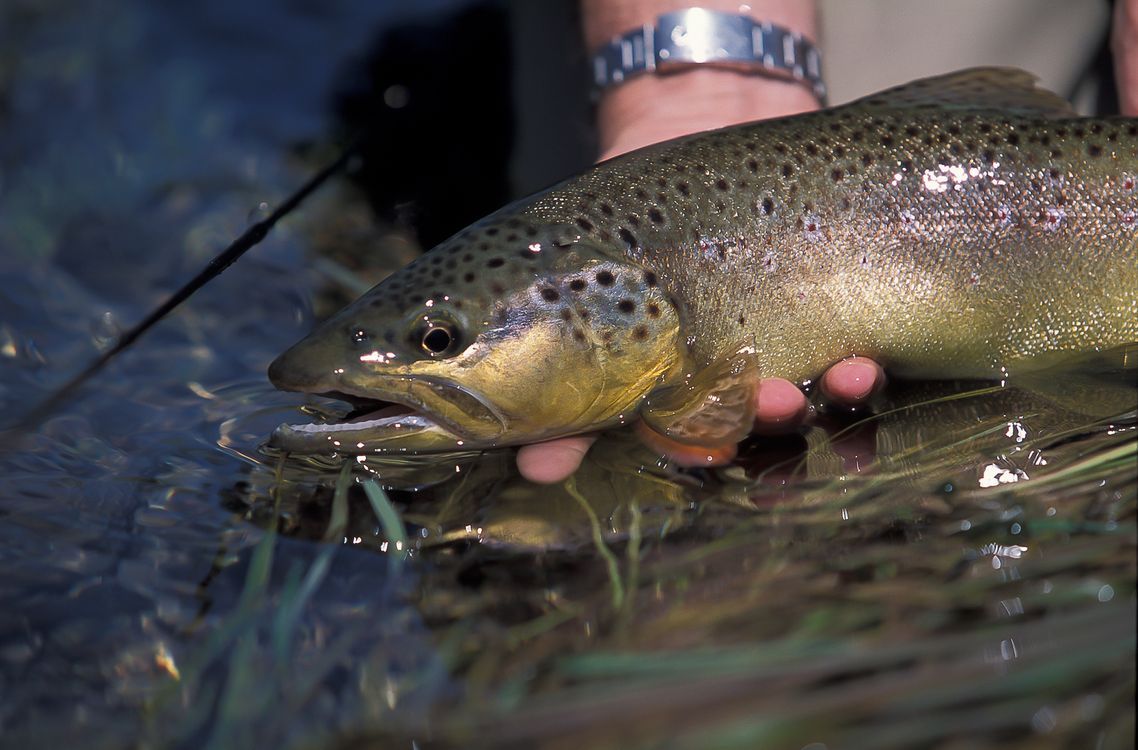
What kind of fish can people catch in Slovenia?
Brown Trout, Marble Trout, Rainbow Trout, and Grayling are what we fly fish for. You can also catch pike and the famous huchen (Danubian Salomon) on traditional fishing gear.
In addition to the fishing, what do people experience on your tours?
Our clients typically fish only part of the day – the rest is filled with the best that there is to experience in Slovenia. Of course, Ljubljana’s old town and Bled are on everyone’s itinerary. But we customize based on what the client is looking for. For example, some recent clients were very excited to have the opportunity to take one afternoon and have lunch at Hiša Franko.
When are the seasons?
The season for fishing in Slovenia kicks off in April and May, with it best when the first hatches of the year come in the various streams – it’s a different time depending on where you are fishing. The season continues through the summer, though it can get crowded in August during holidays. When fall comes, the best fish to look for are grayling. Of course, Huchen (Danubian Salmon) offer the greatest prize in late fall and early winter.
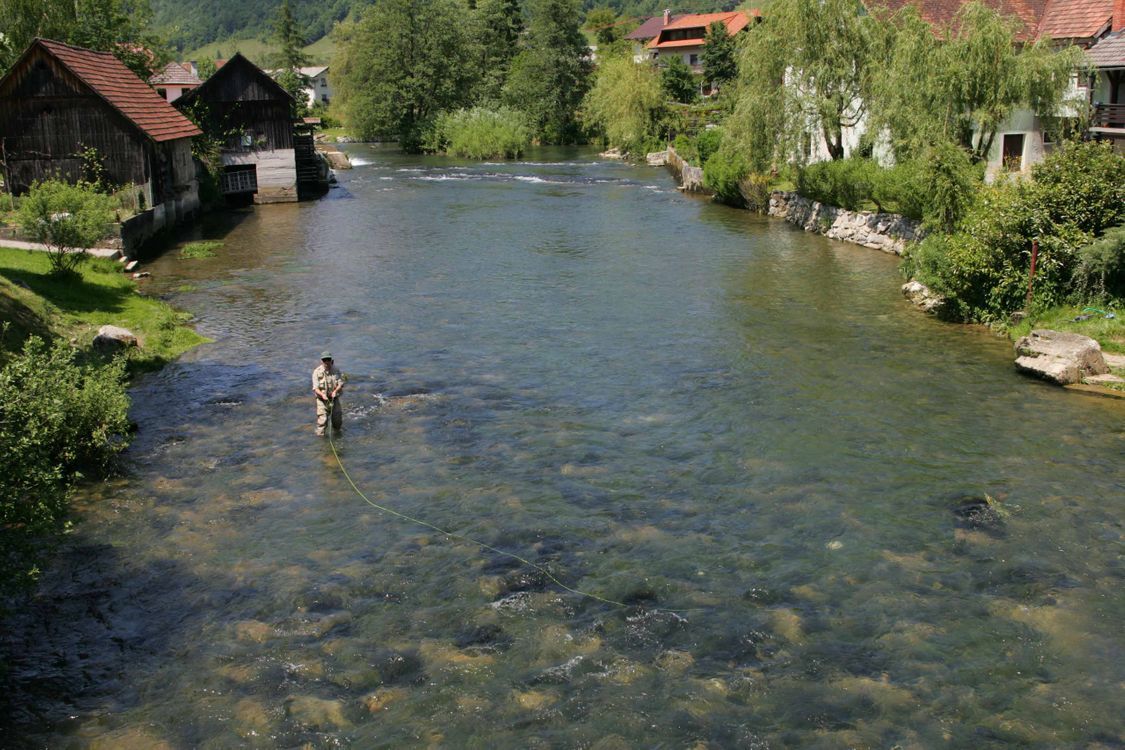
What’s your favorite spot to fish in Slovenia?
Really? I'm not telling… However, the smaller streams that are away from the Soča provide some of the best experiences for fly fishers – to include the Unica, Krka and Idrijca Rivers. We look to take our clients away from the crowds to places like these.
How far in advance do people usually book?
We take care of clients whether they want to fish tomorrow or next summer. Optimally, those who want to fish in Slovenia in the summer of 2019 with us will be booked by January.

What’s are the general profiles of most of your customers?
Most of my clients are Americans. When they are in Slovenia, Americans typically want to see and do what a lot of general tourists want to do. So, we provide turn-key vacation packages for them that include lodging, meals, and excursions – even completely separate itineraries for spouses (Rogaška regularly comes up!). Water Man Adventures also has European clientele, and they are typically more comfortable taking care of their own extra activities. Regardless, we custom design each tour based on what the client wants – no is rarely an answer for us.
Tours that respect Slovenia's culture and environment
Any changes innovations planned for 2019?
We are looking to continue to define this sector of the tourism industry, while conforming to what Slovenes want in the future. Our goal is to provide clients with fantastic experiences fishing in Slovenia, while minimizing impact on the environment and culture of Slovenia. While seeking that balance, we want to ensure that Slovenes are able to benefit, so we’ll use local resources every time that it’s possible to do so.
When you’re not leading tours, or fishing, what do you like to do in Slovenia?
I really enjoy exploring the variety of Slovenia’s regions; whether it’s on a wine road in Primorska or looking for bears in Dolenska – you’ll find me at the end of a dirt road somewhere.
If you’d like to learn a lot more about the trips Richard and his partners offer, then visit the Water Man Adventures website or Facebook page. And if you’d like to see some other ways to spend your holiday in Slovenia, then check out our Ten Ways to Enjoy the River Soča.
Get to Know the 17 Historical Towns of Slovenia
There are many ways to plan a trip around Slovenia and lenses through which to view it, and one way to explore the country is through its historic towns. But how to choose these in a land that’s got so many? One way is by turning to the work of the Association of Historical Towns (and Cities) of Slovenia (Združenje zgodovinskih mest Slovenije), a group that includes 17 mostly medieval towns sited around the country, each of which has its own story to tell, with the full list being Idrija, Jesenice, Kamnik, Koper, Kostanjevica na Krki, Kranj, Metlika, Novo mesto, Piran, Ptuj, Radovljica, Slovenske Konjice, Škofja Loka, Tržič, and Žužemberk.
STA, 29 October - Some 300-kilometre-long hiking trail around the Julian Alps was officially launched last week with organised tours on sections of the route in the Gorenjska and Primorska regions. Mountain and cycling trails are also planned in the region.


